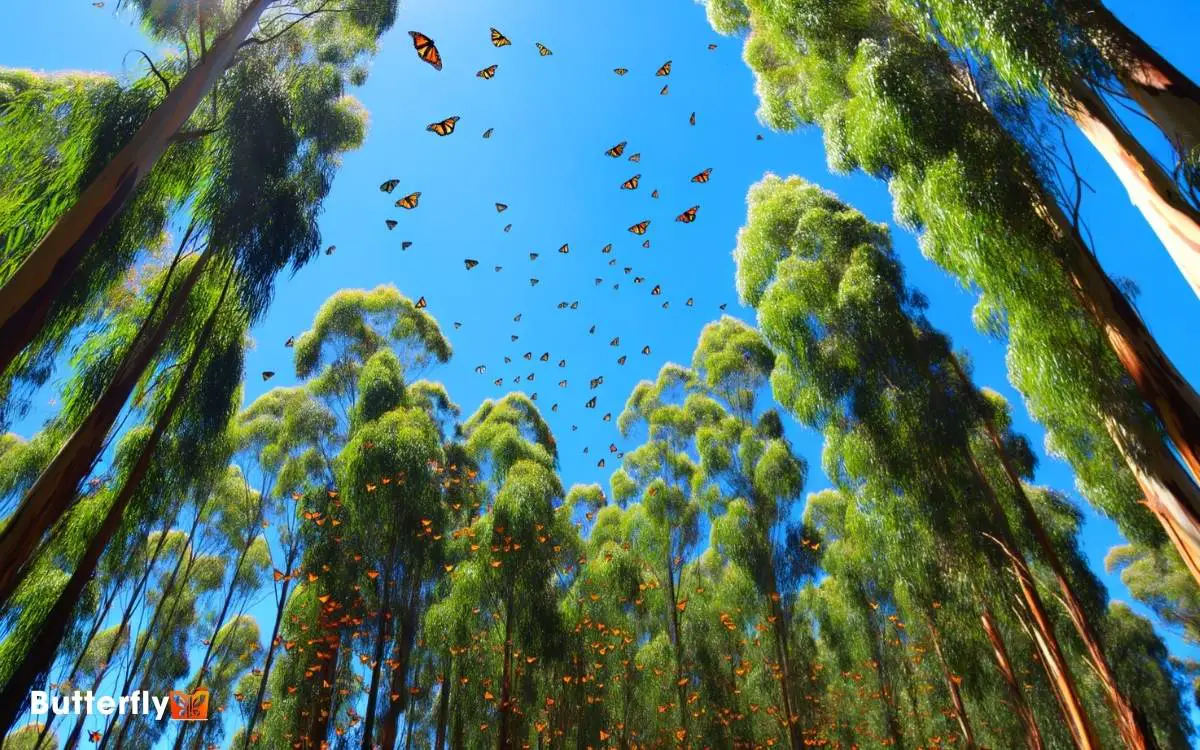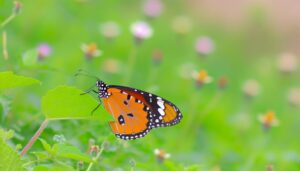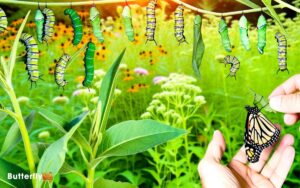Monarch Butterflies in Santa Cruz: Discover Their Journey!
You’ll marvel at the migration of Monarch butterflies to Santa Cruz, covering up to 3,000 miles by using the sun and Earth’s magnetic field. These journeys are multigenerational, triggered by temperature changes and daylight.
In Santa Cruz, eucalyptus groves offer essential microhabitats with stable microclimates for roosting and nectar. Monarchs heavily rely on milkweed for larval nourishment, creating a mutualistic ecosystem.
Conservation focuses on restoring milkweed, monitoring climate, and managing habitat corridors. Local community involvement in restoration and education is crucial to preserving these fascinating insects.
Discover how climatic influences and habitat conservation intertwine in this remarkable phenomenon.

Key Takeaways
Migration Journey
Every fall, monarch butterflies begin an extensive migration journey from North America to the coastal town of Santa Cruz, guided by environmental cues and innate biological mechanisms.
You’ll find that these butterflies rely on the position of the sun and the Earth’s magnetic field to navigate. They travel up to 3,000 miles, covering 50 to 100 miles per day. Their migration is a multigenerational effort; no single butterfly completes the round trip.
Research shows that temperature changes and daylight duration trigger the start of their journey. Additionally, the butterflies utilize thermal air currents to conserve energy during flight.
Arrival in Santa Cruz
As the monarch butterflies reach the coastal haven of Santa Cruz, they gather in dense clusters on eucalyptus and Monterey pine trees, creating a spectacular and scientifically significant overwintering phenomenon.
You’ll notice that the clustering behavior helps conserve heat and energy, essential for their survival during colder months.
Researchers have observed that these butterflies rely on the microclimate provided by the coastal environment, which offers the right temperature and humidity levels.
The butterflies’ arrival is meticulously timed, coinciding with seasonal changes that optimize their chances of survival. By studying their arrival patterns, scientists gain insights into migration cues and climate change impacts.
Your understanding of this phenomenon enhances our collective knowledge of these remarkable creatures and their intricate life cycles.
Eucalyptus Groves
You’ll find that Eucalyptus groves in Santa Cruz provide a vital microhabitat for overwintering Monarch butterflies.
These groves offer a stable microclimate essential for the butterflies’ survival during their seasonal migration.
Researchers have observed that the dense canopy and specific thermal properties of Eucalyptus trees help mitigate temperature fluctuations, ensuring a suitable overwintering environment.
Habitat for Monarchs
Eucalyptus groves in Santa Cruz provide an essential microhabitat for monarch butterflies, offering both shelter from harsh weather and an abundant source of nectar. These groves create a stable environment that supports the delicate needs of monarchs.
Key elements of the eucalyptus habitat include:
- Microclimatic Stability: Eucalyptus leaves maintain consistent moisture and temperature levels.
- Wind Protection: Dense foliage acts as a barrier against strong coastal winds.
- Nectar Availability: Flowers supply a continuous food source during critical periods.
- Roosting Sites: High branches offer safe resting areas away from predators.
These factors contribute to the survival and well-being of monarch butterflies, making eucalyptus groves indispensable for their habitat needs.
Seasonal Migration Patterns
Each fall, monarch butterflies set out on an extraordinary migration journey, maneuvering thousands of miles to reach the eucalyptus groves of Santa Cruz.
You’ll find these groves provide an essential microclimate, offering the necessary thermal stability and humidity.
Monarchs utilize the sun’s position and Earth’s magnetic field as navigational tools, a phenomenon extensively documented in entomological studies.
Research indicates that the eucalyptus trees’ canopy shields the butterflies from inclement weather, while their branches serve as roosting sites.
Observations reveal that these trees also offer nectar sources, crucial for the monarchs’ sustenance during overwintering.
Understanding this intricate migration pattern is essential for conservation efforts, as it highlights the importance of protecting these specific habitats.
Lifecycle and Habitat
Monarch butterflies in Santa Cruz exhibit a fascinating lifecycle, beginning as tiny eggs laid on milkweed plants, which serve as their primary habitat and food source.
After hatching, the larvae (caterpillars) consume milkweed leaves, gaining toxins that deter predators. The caterpillars then enter the pupal stage, forming a chrysalis where metamorphosis occurs.
Finally, they emerge as adult butterflies, ready to start the cycle anew. Key stages in the lifecycle:
- Egg: Laid singly on milkweed leaves.
- Larva (Caterpillar): Feeds exclusively on milkweed.
- Pupa (Chrysalis): Undergoes metamorphosis.
- Adult: Emerges to feed on nectar and reproduce.
Understanding this lifecycle helps you appreciate the monarchs’ dependency on their specialized habitat and food source.
Conservation Efforts
Recognizing the essential role of monarch butterflies in ecosystems, researchers are implementing targeted conservation efforts to protect their fragile habitats in Santa Cruz.
You’ll find that scientists are focusing on restoring native milkweed populations, important for monarch breeding. They’re also monitoring climatic conditions and habitat fragmentation to mitigate adverse impacts.
Detailed field observations reveal that habitat corridors are being established to connect isolated populations, enhancing genetic diversity.
By collaborating with local communities, researchers encourage planting milkweed and nectar sources in urban gardens, enriching the migratory pathways.
Advanced tagging and tracking techniques are utilized to gather data on migration patterns, crucial for adaptive management strategies.
Your understanding of these concerted efforts highlights the importance of scientific intervention in preserving this iconic species.
Viewing Tips
As conservation efforts gain momentum, you can enrich your experience by utilizing these expert tips for viewing monarch butterflies in their natural Santa Cruz habitats.
Observing these Lepidoptera requires a nuanced approach to enhance both your understanding and their preservation.
- Timing: Visit during peak migration seasons, typically late October to February, to witness large congregations.
- Early Visits: Arrive early in the morning when butterflies are less active, allowing closer observation without disturbing them.
- Quiet Presence: Maintain a low noise level; monarchs are sensitive to disturbances which can disrupt their roosting patterns.
- Binoculars: Use binoculars for detailed views of their behaviors and physical characteristics without encroaching on their space.
These strategies will maximize your observational success while minimizing ecological impact.
Impact on Ecosystem
You’ll see that monarch butterflies play a crucial role in pollination, contributing greatly to plant health in Santa Cruz. Research indicates their presence influences species interdependence dynamics, affecting various trophic levels.
Observations show that their migratory patterns help sustain the local ecosystem’s balance.
Pollination and Plant Health
Monarch butterflies play a vital role in maintaining the health and diversity of the Santa Cruz ecosystem. By transferring pollen across various plant species, they promote genetic diversity and robust plant growth.
Observations indicate that monarchs primarily visit milkweed and other native flowering plants, fostering a symbiotic relationship essential to ecosystem stability.
Research shows that their pollination activities help sustain plant resilience against pathogens and environmental stressors.
Key contributions include:
- Enhanced genetic diversity: Monarchs promote cross-pollination, leading to stronger plant populations.
- Increased plant reproduction: Higher pollination rates boost seed production.
- Ecosystem resilience: Diverse plant life supports broader ecological stability.
- Pathogen resistance: Pollinated plants exhibit improved health and resistance.
You’ll find that monarchs are indispensable in maintaining a thriving, balanced ecosystem in Santa Cruz.
Species Interdependence Dynamics
In Santa Cruz, the intricate dynamics of species interdependence reveal how monarch butterflies and native plants mutually bolster ecosystem stability and biodiversity.
Monarchs rely on milkweed for larval nourishment, while milkweed depends on monarchs and other pollinators for reproductive success. This mutualistic relationship promotes the propagation of both species, contributing to a resilient ecological network.
Researchers have observed that such interdependence also enhances genetic diversity, important for adaptation to environmental changes.
By maintaining these interactions, you’re supporting a complex web of life, from soil microbes to apex predators. Disrupting this balance could lead to cascading effects, undermining ecosystem health.
Preserving monarchs and their habitats is essential for maintaining the intricate fabric of Santa Cruz’s biodiversity.
Community Involvement
Local residents in Santa Cruz have played a pivotal role in the conservation efforts for monarch butterflies through organized community initiatives and citizen science projects. You’ve likely seen these efforts firsthand.
By participating, you can contribute to various activities that are scientifically driven and essential for monarch preservation:
- Habitat Restoration: Volunteers plant milkweed and other native flora to support monarch breeding.
- Population Monitoring: Citizen scientists record butterfly counts, providing data for research.
- Educational Workshops: Community-led sessions inform residents about monarch biology and conservation techniques.
- Public Awareness Campaigns: Efforts to spread knowledge about the importance of monarchs and how to help them.
Your involvement ensures ongoing support for these essential pollinators and aids in maintaining their populations.
Conclusion
You’ve journeyed through the remarkable migration of monarch butterflies to Santa Cruz. Witnessed their eucalyptus grove habitats and understood their lifecycle intricacies.
Conservation efforts and community involvement are critical to their survival, akin to knights protecting a medieval kingdom. By visiting respectfully and supporting local initiatives, you’re contributing to their preservation.
Your efforts, like ripples in a pond, guarantee these vibrant pollinators continue enriching our ecosystem for future generations.






